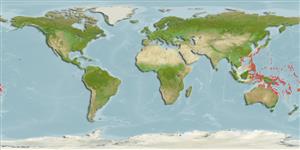Classification / Names
Common names from other countries
Référence principale
Taille / Poids / Âge
Max length : 12.0 cm TL mâle / non sexé; (Ref. 559)
Environnement
; marin démersal
Climat / Gamme
Temperate, preferred ?
Distribution
Description synthétique
Épines dorsales (Total): 11 - 13; Rayons mous dorsaux (Total): 8-10; Épines anales 1; Rayons mous anaux: 8 - 9. Body elongate and compressed, covered with velvety prickles. Preoperculum with 5 blunt spines. Anterior part of dorsal fin higher (2nd and 3rd spines elongate). Body dark-brown with darker mottling (Ref. 559). Isthmus without fleshy pad (Ref. 39602).
Statut dans la liste rouge de l'IUCN (Ref. 115185)
Menace pour l'homme
Harmless
Utilisations par l'homme
Plus d'informations
Noms communsSynonymesMétabolismePrédateursÉcotoxicologieReproductionMaturitéFraiFéconditéŒufsDéveloppement de l'œuf
RéférencesAquacultureProfil d'aquacultureSouchesGénétiqueFréquences alléliquesHéritabilitéPathologiesTraitementMass conversion
CollaborateursImagesStamps, CoinsSonsCiguateraVitesseType de nageSurface branchialeOtolithesCerveauxVision
Outils
Articles particuliers
Télécharger en XML
Sources Internet
Estimates of some properties based on models
Phylogenetic diversity index
PD50 = 0.5078 many relatives (e.g. carps) 0.5 - 2.0 few relatives (e.g. lungfishes)
Niveau trophique
3.4 ±0.5 se; Based on size and trophs of closest relatives
Résilience
Vulnérabilité
Low vulnerability (10 of 100)
Catégorie de prix
